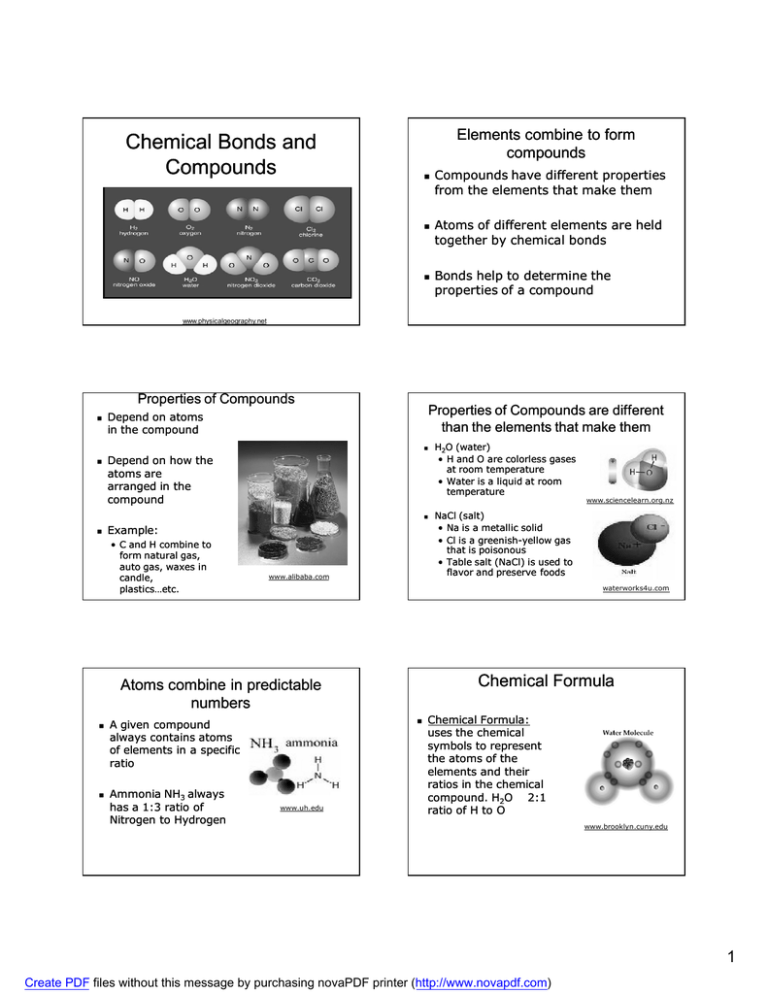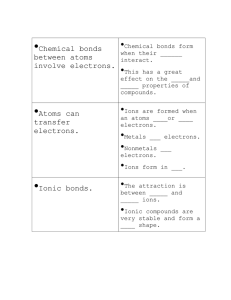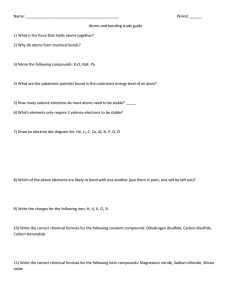Chemical Bonds and Compounds
advertisement

Elements combine to form compounds Chemical Bonds and Compounds Compounds have different properties from the elements that make them Atoms of different elements are held together by chemical bonds Bonds help to determine the properties of a compound www.physicalgeography.net Properties of Compounds Depend on atoms in the compound Depend on how the atoms are arranged in the compound Properties of Compounds are different than the elements that make them www.sciencelearn.org.nz Example: • C and H combine to form natural gas, auto gas, waxes in candle, plastics…etc. www.alibaba.com A given compound always contains atoms of elements in a specific ratio Ammonia NH3 always has a 1:3 ratio of Nitrogen to Hydrogen NaCl (salt) • Na is a metallic solid • Cl is a greenishgreenish-yellow gas that is poisonous • Table salt (NaCl) is used to flavor and preserve foods waterworks4u.com Chemical Formula Atoms combine in predictable numbers H2O (water) • H and O are colorless gases at room temperature • Water is a liquid at room temperature www.uh.edu Chemical Formula: uses the chemical symbols to represent the atoms of the elements and their ratios in the chemical compound. H2O 2:1 ratio of H to O www.brooklyn.cuny.edu 1 Create PDF files without this message by purchasing novaPDF printer (http://www.novapdf.com) Chemical Bonds hold Compounds Together Chemical bonds are the “glue” that holds the atoms of elements together Chemical bonds form when the electrons in the electron clouds interact bioactive.mrkirkscience.com www.bennett29j.k12.co.us An elements location on the periodic table gives a clue as to the type of ions the atoms of that element will form Group 1 metals (Li, Na, K…) usually lose one electron to form positive ions. Group 2 metals (Be, Mg, Ca…) usually lose two electrons to form positive ions. Group 17 nonmetals (F, Cl, Br…) gain one electron to form ions with a 11- charge. Group 16 nonmetals (O, S, Se…) gain two electrons to form ions with a 22- charge. Atoms can transfer electrons Ions are formed when atoms gain or lose electrons Gaining electrons = negative charge Losing electrons= positive charge Ionic Bonds Group 1 Group 1 lose eeGroup 2 lose 2e 2e-- Group 17 gains 1 eeGroup 16 gains 2 ee- The force of attraction between positive and negative ions. Particles with opposite electrical charges attract each other Atom from element group 1 (1+) combines with an atom from element group 17 (1(1-) to form an ion. Example Na combines with Cl • Na loses 1 electron and Cl gains the electron • Creating an ionic bond 2 Create PDF files without this message by purchasing novaPDF printer (http://www.novapdf.com) Ionic compounds Names of Ionic Compounds Ionic bonds form between all nearby ions of opposite charge. Ionic compounds are very stable and their crystals are very strong. The shape of the crystals formed depends on the ratio of positive to negative ions and the sizes of the ions Covalent Bonds A pair of shared electrons between atoms.(prefix co co-- means partner) Neither atom gains or loses an electron The shared electrons are attracted to both positively charged nuclei. (nucleus has a positive charge because of protons) A covalent bond is represented by a line between the two atoms I2 I-I First, take the name of the positive metal element Second, take the name of the negative, nonmetal element and give it an –ide ending Third, combine the two names Example: BaI2 1: barium 2: Iodine…add ide…Iodide 3: barium iodide Covalent Bond The number of covalent bonds that an atom can form depends on the number of electrons that it has available for sharing. • Atoms of Group 16 (O,S…)can form two covalent bonds. • Atoms of group 15 (N,P…) can form three bonds • Atoms of group 14 (C, Si…)can form four bonds Finding Valence Electrons Valence Electrons Valence electrons: are the electrons in the outer electron cloud. Electrons orbit in shells: 2, 8, 18, 32, 50 (Inner shell is 2, next shell has 8 electrons…) A quick way to determine the number of valence electrons for a representative element is to look at which group it is in. Elements in group 1 have 1 valence electron. Elements in group 2 have 2 valence For example: Sodium has an Atomic Number of 11 This means an atom of Sodium has 11 Protons and therefore 11 electrons. The electrons are arranged as: • First Shell = 2, • Second Shell = 8, • Third Shell = 1 • (Giving a total of 11.) (2+8+1=11) Na has 1 valence electron and is in group 1 http://www.ecawa.asn.au/home/jfuller/chemistry/chem2.htm 3 Create PDF files without this message by purchasing novaPDF printer (http://www.novapdf.com) Chemical Bonds Give all Materials their Structure Ionic Compounds (losing/gaining ee-) • Most have a crystal structure • Solid at room temperature • High melting and boiling points (takes a lot of energy to break the bond) • Hard, brittle, good conductors of electricity once the ions are separated • Dissolve easily in water Chemical Bonds Give all Materials their Structure Covalent Compounds (sharing valence ee-) • Exist as individual molecules • Chemical bonds give each molecule a specific three--dimensional shape three • Molecular shape can affect properties of the compounds • Melt and boil at lower temperatures (takes less energy to break up because atoms are organized as individual molecules) www.ndt-ed.org Metals have unique bonds Metallic bond: bond: the equal sharing of electrons in all directions so electrons move easily among the atoms of the metal Atoms can slide past one another in metallic bonds which allows for easy shaping Properties of metals depend on bonds • Good conductors of electric current • High melting point • Solid at room temperature (except Hg) • Easily shaped and pounded 4 Create PDF files without this message by purchasing novaPDF printer (http://www.novapdf.com)



